At the request of a few readers, (including Fran M), here are this week’s cartoons.
Sign of the times:

Israel’s dilemma:

Both sides:

Republican talking point:

Halloween was the same as any other night for the grifter:

The Daily Escape:

Tug pushing barge Tongass Provider in Dutch Harbor, AK. This is the last big load of the season heading north before ice prevents boat travel – October 29, 2023 photo by Richard McKinley. Note how small the trucks and RVs look relative to all of the goods on the barge!
Saturday is when the Wrongologist expects to offer his readers a chance to calm down after what has become our all-too-common weeks of domestic and international horrors. We call this the “Saturday Soother”, but this week, once again, it may prove difficult to find soothing.
Wrongo’s column on Tuesday ended by asking:
“Can Biden broker a peace when neither side wants one?”
Friend of the blog, Brendan K. who has military experience in the Middle East (ME) said in response:
“A peace does need to be brokered, but by Arab leadership with Israel. Biden has no relevance in the Arab World…”
The point is that the US cannot be a staunch supporter of Israel and also be an honest broker between the combatants. That the US isn’t trustable isn’t a new idea in the Middle East; this has been an issue in most conflicts involving Israel for decades.
But it seems that the window on a brokered end to hostilities in Gaza may not be open for long. The idea that Israel has crossed the line of proportionality in their attacks on Gaza is growing among western countries, while the idea that Arabs must stand in solidarity with Hamas vs. Israel also seems to be growing throughout the world.
We don’t need to look very hard to find examples of how US actions with Israel compromise its possible value to broker peace. The Intercept has a story about the US building a secret base inside Israel:
“Two months before Hamas attacked Israel, the Pentagon awarded a multimillion-dollar contract to build US troop facilities for a secret base it maintains…within Israel’s Negev desert, just 20 miles from Gaza. Code-named “Site 512,” the longstanding US base is a radar facility that monitors the skies for missile attacks on Israel.”
In addition to hosting a radar site that is pointed toward Iran, the Army is constructing a “life support facility” there, which is military-speak for barracks for personnel. All of this is despite Biden insisting that there are no plans to send US troops to Israel given the war on Hamas. But the Intercept claims that a secret US military presence in Israel already exists. Apparently sites like this can house as many as 1,000 troops.
Add what the NYT reported on Friday about US drones over Gaza:
“The US military is flying surveillance drones over the Gaza Strip, according to two Defense Department officials and an analysis by The New York Times. The officials said the drones were being used to aid in hostage recovery efforts, indicating that the US is more involved than previously known.”
The Defense Department told the NYT that these unarmed surveillance flights are not supporting Israeli military operations on the ground. Instead, the goal was to assist in locating hostages, and pass potential leads to the Israel Defense Forces (IDF). Wrongo finds the claim that these drones have a single mission to be laughable. In addition, several dozen American commandos are now on the ground in Israel. This view of drone flight patterns is from the NYT:

Flights shown here are from Oct. 28 to Nov. 2, of which at least six flights were over Gaza. Flight path data is from FlightRadar24. Paths are approximate based on each flight’s reported position about every minute.
Hassan Nasrallah, head of Hezbollah in Lebanon offered a warning to Israel and the US when he spoke for the first time since the start of the Israel/Hamas war. The WSJ had some key takeaways from his televised address:
Nasrallah also cautioned Israel against launching a preemptive strike:
“I tell the Israelis, if you are considering carrying out a preemptive attack against Lebanon, it will be the most foolish mistake you make in your entire existence.”
Worse, the WSJ reports that the Wagner Group, the Russian mercenary outfit, plans to send air defenses to Hezbollah, which would be a major escalation in the Israel/Hamas war.
As expected, Netanyahu barked back with his own threat, warning Israel’s “enemies in the north” not to make the costly mistake of escalating the war:
“You cannot imagine how much this will cost you.”
It is very clear that Israel has forgotten 2006. Back then, Hezbollah attacked Israel, who responded by attacking civilian targets in Lebanon in an effort to make the Lebanese government and people think that Hezbollah brought death and destruction to their country. The opposite effect happened with most Lebanese Muslims increasing their approval or support for Hezbollah, while even Lebanese Christians, normally not friendly to Islamic parties or militias, blamed Israel for attacking civilian targets as an act of punishment.
Doesn’t that sound just like the Israeli strategy in Gaza today, 17 years later? US Secretary of State Blinken also issued a warning:
“With regard to Lebanon, with regard to Hezbollah, with regard to Iran, we have been very clear from the outset that we are determined that there not be a second or third front opened in this conflict. President Biden said on day one to anyone thinking of opening a second front, taking advantage of the situation, don’t. And we’ve backed up those words …with practical deeds.”
Wrongo is unsure what “practical deeds” Blinken is talking about. But it seems apparent that the warfighting strategy for Israel’s opponents is to continue to push the US into a position to overcommit until we can do no more. Wrongo thinks that Nasrallah will be reluctant to order a large missile attack against Israel because he knows that Israel will again attack Lebanese infrastructure with the complete blessing of the US.
As it presently stands, the Israel/Gaza situation is grim. There aren’t any reasons to expect Israel to voluntarily stop its ground operation, nor any indications as of yet that the Arab states are seriously considering attempting a diplomatic effort to achieve a cease fire.
Wrongo asked friend of the blog Brendan K. if he had an idea about how to extract Biden from the Israeli briar patch. And now Wrongo asks all readers: How/who has the ability to bring both sides to the table?
And here’s a music interlude that attempts to take our minds off of the ME for a few minutes. Watch and listen to “Hedwig’s Theme” by John Williams from Harry Potter performed at the BBC Proms Film Music night in 2011:
The Daily Escape:

First snowfall, Tanglewood, Berkshires, MA – November 1, 2023 photo via Tanglewood Music Festival
For Wrongo, there have been few events that seemed immediately to foreshadow a change in our lives. The first was the assassinations of JFK and MLK. Although they were five years apart, they each signaled turning points. Wrongo felt that way about Hurricane Katrina and 9/11. Both conveyed the thought that our government was helpless against forces it didn’t control or understand.
Then came the election of Donald Trump, and now, the Hamas/Israel war — threats that we couldn’t process with conventional thinking.
In all of these cases, it was clear that something truly catastrophic had occurred, and that we had no idea how America, or the world, would respond.
Now we face the Hamas/Israel war. We’re trying to sort out how to react to what is in front of us every night as the day’s reports from Gaza arrive. It’s hard to watch the discourse around what’s happening in Gaza. The messages from both sides are depressing, since they both look the death and destruction in the face and say it’s caused by the other guy. It’s difficult to see how this ends.
Israel remains under rocket attacks both from Hamas in Gaza and from Hezbollah in Lebanon. We know that Hamas is holding hundreds of hostages in tunnels that are below densely-populated neighborhoods.
The security systems that were designed to protect Israelis were proven wholly inadequate on Oct.7. Netanyahu and the coalition government have been discredited yet remain in power. The people demand justice and that security be provided somehow.
Israel doesn’t want a cease fire, yet that is what Hamas and a growing number of countries are pushing for.
OTOH, what Israel is attempting to do is nearly impossible. How do a million people get moved from the north of Gaza to the South? What makes sense about Israel’s plans to dismantle many of the homes and much of the infrastructure that the northern Gazans depend on, along with some 300 kilometers of tunnels? Why is it a moral war if Israel is willing and able to kill anyone who remains in the area? And when Israel is finished in the north, is there any assurance that they won’t turn to the south where they told the northern Gazans to go?
But as Simon Rosenberg says:
“It’s important to listen to the actual words of Hamas: – Israel must be eliminated, more attacks are coming – Killing of Jews/Americans in Israel is justified – Loss of life in Gaza is acceptable, as we are a “nation of martyrs”
Rosenberg shows this video by Hamas Official Ghazi Hamad in which he says:
“We Will Repeat the October 7 Attack Time and Again Until Israel Is Annihilated; We Are Victims – Everything We Do Is Justified”
And do you really think that Netanyahu will get some kind of deal for hostages done? We need to accept that most of them will be martyrs to the Israeli cause if the war continues. Does anyone believe that Hamas can be made to release the hostages and then surrender to Israel? Even though Hamas initiated this conflict and they could save their own people by taking responsibility, that’s not going to happen.
Where does this leave the US? Biden woke up on Oct. 7 to find himself thrust into the middle of the second major foreign-policy crisis of his term. He embraced Israel, along with what now look like two conflicting imperatives: Support Israel and prevent an escalation of the war.
There’s also a brewing political crisis at home. Polls show that most Americans side with Israel in the conflict and approve of both Israel’s retaliation against Hamas and US support for it. Republicans tend to be more supportive of Israel than Democrats, who have become more sympathetic toward Palestinians over the past several years. But majorities in both Parties are broadly supportive of Israel.
Yet Biden’s unconditional Israel support also brings the risk of regional escalation. Despite his efforts to convince the Israeli government to limit the scope and scale of its military response to Hamas’s attack and consider a “humanitarian pause,” Israel launched its ground invasion anyway.
The offensive will inevitably inflict large-scale Palestinian casualties (especially since Hamas will continue to put civilians between them and the Israelis). It will also lead to a marked escalation in attacks on Israel and US interests across the Middle East that could easily destabilize the region.
Unlike the war in Ukraine, where the US has worked hard to ensure that support of Kyiv doesn’t risk direct military confrontation between them and Russia, the US risks becoming directly involved in the Israel/Hamas war. For better or worse, Biden owns it, if it happens.
While most voters are aligned with Biden’s stance on the war, it poses two political challenges to Biden’s 2024 prospects from the Left and the Right.
From the Right, Biden will be accused of projecting weakness on the global stage. Trump is already making the false case that the two major wars of Biden’s term happened only because Biden’s weakness emboldened our adversaries. Trump will argue that the relative ME calm during his administration was due to his strategy of “peace through strength,” particularly with Russia and Iran. He’ll claim that neither would have dared test the US had he been in office.
Will this be compelling for Republican-leaning swing voters? Remember that Trump’s Abraham Accords – which normalized diplomatic relations between Israel and the United Arab Emirates, Bahrain, Morocco, and Sudan, ignored the Palestinians and helped sow the seeds for the Oct. 7 attack. Also that Trump’s constant threats to NATO were a gift to Putin.
Regardless of what happens next, Biden will always be the president on whose watch these two wars – both of which the US is funding, started.
From the Left, Biden will be accused of enabling Israel’s killing of innocent Palestinians. A CNN poll from earlier this month shows that just 27% of 18-to-34-year-olds view Israel’s military response to the Hamas attacks as “fully justified,” compared to 81% of those 65 or older. Then there’s Muslim and Arab-American voters, around two-thirds of whom backed Biden in 2020. Recent polls show that very few of them plan to vote for Biden again in 2024.
Faced with the Biden vs. Trump choice, these voters (who were an important part of the Democratic coalition in 2020 and 2022) would probably stick with Biden as the lesser evil (or stay home and thereby benefit Trump).
But third-party candidates like Cornel West, who is critical of Israel, could hurt Biden. A USA Today poll shows West already picking up between 4-7% of the vote nationally, primarily from Biden. It would only take 2-3 percentage points for West to be a spoiler in a swing state like Wisconsin, potentially tipping the balance to Trump in a close election.
At the same time, a Middle East crisis that Biden can’t fix could hurt him particularly if the war escalates. Biden will also bear the burden for any terrorist and antisemitic attacks in the US between now and the end of his term.
Can Biden broker a peace when neither side wants one?
For now, Biden is the narrow favorite to win reelection, largely because of Trump’s extraordinary criminality and his unique weaknesses. But if the ME is still dominating our headlines in November 2024, all bets are off.
The Daily Escape:

Sunrise, Northern VT – October 2023 photo by Kristen Wilkinson Photography
The UAW announced Monday evening it had reached a tentative agreement with GM, the last of the Detroit car companies to complete negotiations with the Union. So all three have a tentative agreement which will now be voted on by UAW members. This is a big deal, even if nobody’s talking about it.
Some details from The Insider:
“The 25% pay increases by April 2028 agreed to in the new contracts raise top pay to about $42 an hour, according to the union. That starts with an 11% immediate boost upon ratification, three annual raises of 3% each, and a final increase of 5%. The UAW said restoration of cost-of-living increases, which were suspended in 2009, could boost the total increases to more than 30%.”
Some industry analysts have estimated that Ford’s contract, if ratified, would add $1.5 billion to the company’s annual labor costs. Ford estimated that this could add up to $900 in labor cost to each vehicle rolling off its assembly lines. Another analyst says the pact will reduce profitability by 1%. To put these numbers into perspective, keep in mind that a fully loaded Ford F150 can run over $80k. That means the car companies can afford this deal.
Labor accounts for 4-5% of the average cost of making a car for the Big Three. Also, the Big 3 have made $250 billion in profits over the past decade and have diverted a substantial amount of that money into stock buybacks to enrich wealthy shareholders and top executives instead of investing in their businesses or paying their workers.
So please spare us the tears about the workers’ hard-fought gains putting the Big 3 in peril. The NYT wrote:
“The terms will be costly for the automakers as they undertake a switch to electric vehicles, while setting the stage for labor strife and demands for higher pay at nonunion automakers like Tesla and Toyota.”
To paraphrase, the NYT says that those evil unions are ruining shareholder value and will cause strife at Tesla, a company renowned for its fantastic working conditions.
Be it ever thus in the media: Unions demand, management offers. Note how the media framing is always “the automakers” as the protagonists, with workers as a mob that’s making trouble. Why can’t those workers be happy and content with their lot in life, which is ordained for them by the Higher Power?
Back in the real world, the tentative UAW agreement rewards autoworkers who had sacrificed much during and since the Great Financial Crisis. They now get record raises, more paid leave, greater retirement security, and more rights at work.
The UAW win is a testament to the power of unions and collective bargaining to build strong middle-class jobs, while helping a few of our most iconic American companies to thrive. The UAW workers have not only seen many of their jobs automated and offshored, they also hadn’t received an inflation-adjusted raise since the early 2000’s.
That the UAW prevailed shows that unionizing on a large scale is a viable path to rebuilding America’s middle class. Fed up with continual economic hardship at the hands of the Big 3’s management, these strikers achieved something good for themselves and their families. Moreover, they did it legally. Despite the NYT’s protests, they didn’t steal anything from anyone. They didn’t ask for handouts. They demanded a good future for themselves and their families.
This should be a lesson to all people whose labor is undervalued. You can organize and negotiate better contracts for yourselves.
And don’t underestimate how important a low rate of unemployment is to low-wage and working-class Americans, and how that also gives unions leverage. Biden’s American Rescue Plan Act of 2021 provided an economic stimulus that boosted US consumer purchasing power to the point that we avoided the expected recession. And today’s scarcity value of labor helped close the deal with the Big 3.
For some context, these landmark gains by the UAW, along with what the Teamsters secured with their UPS contract, and what health care support staff got at Kaiser Permanente go far beyond the pay and benefits that workers receive at their non-union counterparts. Except for railroad workers, it’s been a very good year for unions.
Once again, Biden took a risk that he hadn’t before by explicitly siding with the UAW. It paid off for him and the Union as well.
Finally, kudos to Shawn Fain and the UAW negotiating team!
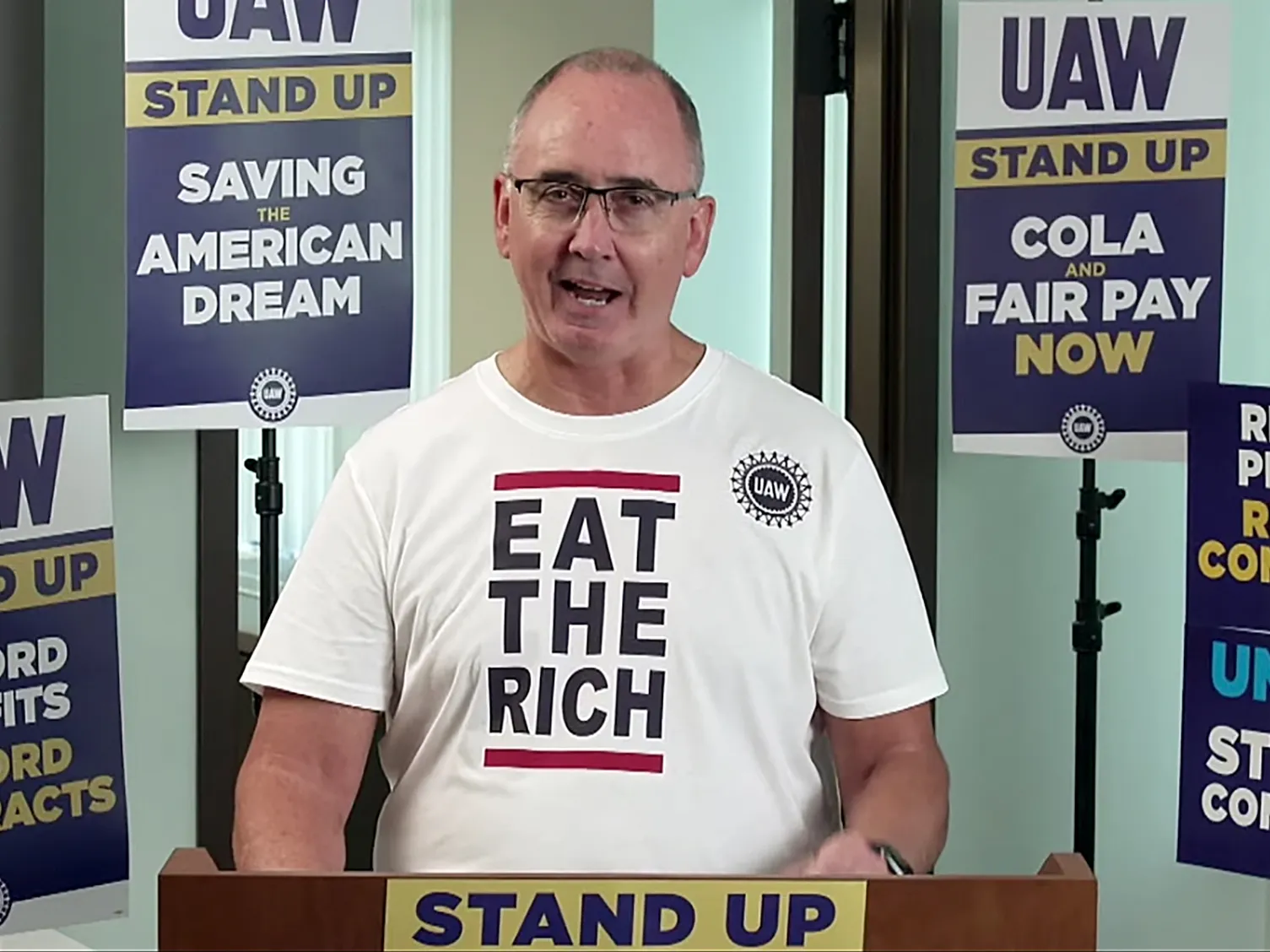
Wrongo appreciates that Fain seems to understand class consciousness by describing the workers as working class. And their strategy was pure divide and conquer.
The final word on these tentative agreements will ultimately come from UAW members themselves when they vote on the new contracts.
The Daily Escape:

Lenticular clouds over Mt. Adams, WA – October 2023 photo by Mitch Schreiber Photography
The news is awful and the time to cover it is short. So here’s a few thoughts on the fly:
First, about Lewiston. This is another American tragedy caused by the AR-15. The effort to paint the problem as another mentally-ill person who unfortunately happened to snap has already begun.
And on average, more than one gun per capita is owned by Americans. The Framers couldn’t have conceived of such violence from one gun. Wrongo is fully aware that it is highly unlikely that guns will ever be brought under better control, unless we happen to become the autocracy that many on the Right want us to be.
The Supreme Court’s ideas about originalism and what was meant by a “well-regulated militia” back in the 1770s, made Wrongo take a look at the demographics of the era. In 1790, the US population was around 3.9 million people, excluding Indians and slaves (as they did back then).
And if you try to determine what a rifle owned by one of America’s well-regulated militia cost in the 1770s, you uncover an almost insoluble problem. There was no national currency, each state had its own. Most were expressed in pounds, but each varied in value in relation to the English pound that they were based on.
Despite all of the problems of comparisons, in 1775, a week’s wages for a Massachusetts agricultural laborer were about 3.75 MA pounds. Across the colonies, a long rifle of medium quality cost between 4-7 pounds, so an average worker could acquire a rifle for less than two week’s wages.
That probably meant that like today, there were at least as many guns as men in colonial America.
The well-regulated militia as a deterrent to tyranny made sense until the time of muzzle loaders came to an end. From roughly 1500 – 1850, militias could fight on relatively equal ground with professional soldiers. But once artillery got good enough to chew up massed formations with only a few cannons, the rifle and other small arms became of secondary value in the fight against tyranny because citizen militias could no longer stand up to formal militaries.
Today, small arms play a different role in combat than when the Constitution was written. If the Second Amendment people were serious about wanting to be able to fight off their government they should be arguing to legalize artillery and explosives. They should conduct anti-armored drone drills, weekend artillery practice, and crowd-fund air defense systems.
Think of it as: Today, guns are worthless for fighting tyranny, but they’re perfect for imposing it.
Now, onward to the House of Representatives, and the new Republican Speaker of the House, Mike Johnson, (R-LA). We now have an insurrectionist religious fundamentalist conspiracy theorist who’s second in line for the presidency should something happen to Biden. The House GOP caucus just unanimously elected a traitor.
This needs to be on billboards nationwide.
The election of Johnson represents the surrender by the remaining non-MAGA Republicans to the minority MAGA fringe of their Party. It is a debacle for what the GOP used to stand for in America. And given that funding for the government runs out in a few weeks, a fight between what is now a fully-controlled MAGA House and the House Democrats is inevitable.
To say you’re a Republican in America in 2023 but don’t support Trump makes about as much sense as saying you’re a Communist Party member in the USSR in 1950 but don’t support Stalin.
We should expect a very long shutdown.
House Democrats have to make their fights with House Republicans as loud as possible. They need to make public remarks every day, regardless of their impact on private negotiations. Dems need to make sure everyone knows what the demands by Johnson and the MAGA extremists he leads mean to citizens.
We have to expect that Beltway pundits and the editorial boards of the WaPo and the NYT will attempt to push Biden and Democrats to work with the new Speaker. But, that is a lost cause. House Democrats should work in a bipartisan manner with the (slightly) more reasonable Senate and then turn the fight back to the GOP House in a big public event.
Here’s a tweet by Politico’s Jonathan Martin:
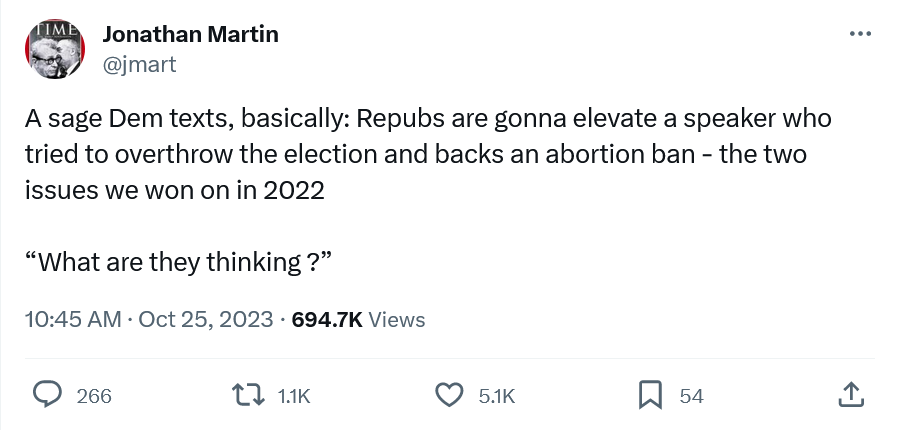
Martin sees this as giving a political advantage to Democrats, but the problem he ignores is the chaos. Is it possible that any order can come out of the MAGA chaos? Johnson is still vulnerable to the rule that a single disgruntled Republican House member can initiate the process to oust him, just as Matt Gaetz (R-FL) did with former Speaker Kevin McCarthy.
If four of the other 220 House Republicans agree, he will lose his job. So a reasonable view is to expect more Republican chaos.
Buckle up, it’s going to be a roller coaster ride from here to next November.
The Daily Escape:

View of fall colors and Linn Cove Viaduct, Banner Elk, NC – October 2023 photo by David Peak
Polls continue to show that people think the economy is terrible and that it’s Biden’s fault. Biden supporters chalk it up to the general unreliability of surveys: Asking people questions and then assuming their answers are accurate or honest. But often, they are not because people find it difficult to say, “I don’t know.”
A second issue is the astounding changes in polling data over the past decade: People’s self-reported emotional state in 2022 was worse than the very worst events of the past few decades. But are things as bad as people seem to think? From Barry Ritholtz:
“From an economic standpoint, things are much better than people seem to be willing to admit: The rate of inflation has plummeted by two-thirds from 9% to a little over 3%, but 60% of respondents believe inflation is “continuing to increase.” The economy is not on the right track, even as Americans’ Net Worth Surged by Most in Decades During Pandemic.”
And the political fallout may be worse than you think. Bloomberg’s recent poll reveals some significant danger for Biden:
“Donald Trump is leading President Joe Biden in several key swing states as voters reject the economic message that is central to Biden’s reelection bid….Trump…leads Biden 47% to 43% among voters in Arizona, Georgia, Michigan, Nevada, North Carolina, Pennsylvania and Wisconsin. The results across those seven states had a margin of error of 1 percentage point.”
Thirteen months before the election, Biden lags Trump in head-to-head matchups in five of the seven swing states. These states will be particularly important in delivering the electoral votes that decide who will be the next president. More from Bloomberg:
“A 51% majority of swing-state voters said the national economy was better off during the Trump administration, and similar numbers said they would trust Trump over Biden on the economy going forward, 49% to 35%. Among independent voters, the chasm on trust to handle the economy is even wider, with a 22-point advantage for Trump.”
Seems like a problem. This is despite the fact that, since 2019, households invested more, home values have jumped, and savings levels have risen. Here’s more from Bloomberg’s polling partner Morning Consult’s Caroline Bye:
“Right now, Biden is not getting any credit for work he’s done on the economy….Almost twice as many voters in the swing states are saying that Bidenomics is bad for the economy, as opposed to good for the economy, which is a really startling fact if you’re the Biden campaign.”
Why is it that people’s perception doesn’t match the data? Back to Ritholtz, who thinks the fault may lie with the media:
“…the 2010s seems to be when they shifted their online presence to a much more aggressive stance. Perhaps most significant is in the way coverage became increasingly “click-bait” oriented via headlines filled with emotionally loaded language….Words that conveyed “Disgust” rose 29% and “Sadness” was 54% higher; words that reflected “Anger” were up 104%. The biggest gain was from perhaps the most emotionally loaded word: “Fear” skyrocketed by a huge 150%. And the words expressing “Joy” or “Neutral?” Down 14% and 30% respectively.”
But it isn’t just the media’s headlines that are hurting people’s perceptions; it’s also the choice of what the media covers that can lead us astray. Ritholtz provides us with a fantastic chart about the causes of death in the US from Our World in Data comparing actual causes of death with what was reported in the NYT:
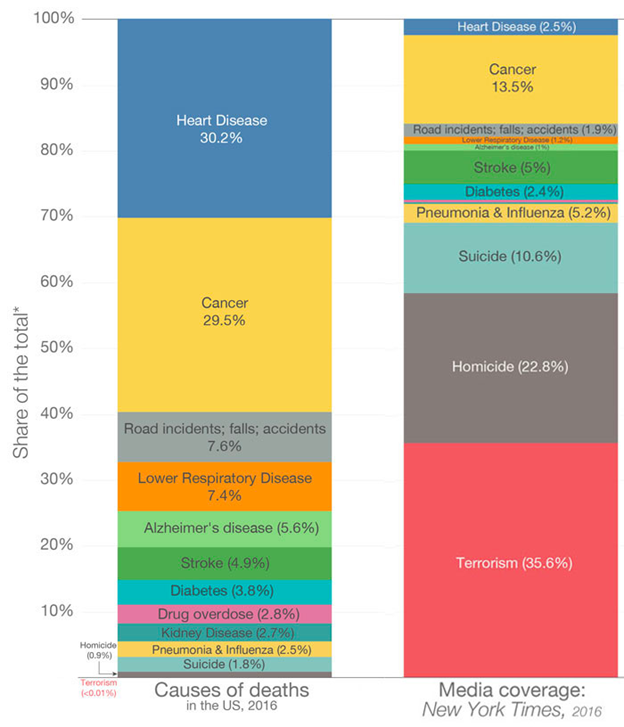
This shows that the way the media covers deaths this is totally inverted: The things least likely to kill you get the most coverage: The bar chart on the right shows Terrorism, Homicide, and Suicide capture about 70% of the column inches. This is despite the odds that you are most likely to die from heart disease (30.2%), cancer (29.5%), or a car accident or fall (7.6%). The very bottom of the list are suicide at 1.8%, homicide at 0.9%, and terrorism at 0.01%.
So do negatively-laden headlines matched with wildly disproportionate coverage combine to send sentiment readings to places that do not match the reality of the economy or more broadly, the real world around us?
We’ve always had sensationalist journalism. The media’s response to social media is to approach news coverage in a similar manner to social media. Apparently the business plan is: If you can’t beat ’em, join ’em. It’s important to remember that we are what we eat, including our media diet. It’s making us unhappy, and increasingly detached from reality.
There are a few economic realities that may help explain where the public is right now:
From a behavioral economics viewpoint, the extent of peoples’ reaction to price inflation may reflect the concept that people are loss averse: that is, they dislike what they perceive as losses more than they like what they perceive as gains.
This means if prices and wages were to increase at the same rate, politicians might assume that people would be indifferent to the nominal changes in prices, since they would be offset by wage increases. But if Americans are loss averse, when prices and wages both go up by a significant amount, (as they have over the past three years), people feel worse, because the “loss” incurred through higher prices feels worse than the “gain” of higher wages.
Time to wake up America! Perception isn’t fact until it is. How Dems fight this will determine the outcome of the 2024 election. To help you wake up, watch and listen to Bruce Springsteen perform “How Can a Poor Man Stand Such Times and Live”, live at the New Orleans Jazz & Heritage Festival in 2006. This is one year after Katrina, which Bruce focuses on at the start of the song:
Sample Lyrics:
Well, the doctor comes ’round here with his face all bright
And he says, “In a little while you’ll be all right”
All he gives is a humbug pill, a dose of dope and a great big bill
Tell me, how can a poor man stand such times and live?
The Daily Escape:

First snow, Great Balsam Mountains, Canton, NC – October 2023 photo by Brandon Montgomery
“To hope is to risk frustration. Therefore, make up your mind to risk frustration.” – Thomas Merton
Everyone’s talking about Hamas, the Gaza hospital and Jim Jordan. Wrongo is certain to write more about those issues, but today, let’s talk about two polls that seem to be telling us a lot about what Americans are feeling right now.
First, the survey by Pew Research “Americans’ Dismal Views of the Nation’s Politics” confirms that millions of Americans are feeling so exhausted and depressed by American politics that they are disengaging from it just when its important to fully engage. Some highlights:
Here’s the tag cloud from Pew:
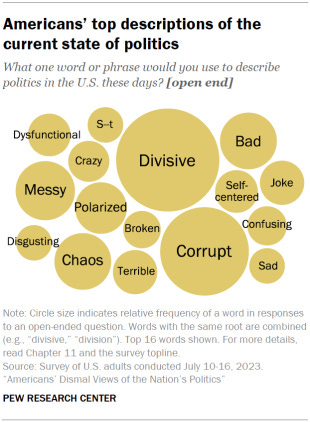
Notice that there aren’t any positive words that made the cut from the responses. From Robert Hubbell:
“It is no wonder that people want to disengage and look away. Exhaustion is the point of MAGA extremism.”
Hubbell goes on to point out that Republicans turn every issue into an attack:
“Impeach Trump? We’ll impeach Joe Biden, Merrick Garland, Jack Smith, Alejandro Mayorkas, and Christopher Wray.
Indict Trump? We’ll indict Hunter Biden, Hillary Clinton, Nancy Pelosi, and Joe Biden.
Protect Americans from a deadly virus? We’ll undermine trust in science.
Fight human-caused climate change? We will make it illegal to discuss climate change in the classroom.”
These responses are part of a mind game designed to make Democrats and Independents give up and go away. But his great idea is this:
“We have one job: To endure, to abide, to keep the faith until this moment of reactionary extremism subsides. If we can do that, we will leave to our heirs a healthier, stronger democracy.”
John Dean Also wrote about this:
“…I was thinking about how Barack Obama won the presidency in 2008. The first thing that came to mind was his iconic poster with his image and the word “HOPE.” That differentiated Obama from his Democratic party competitors…and his Republican rival, John McCain. Obama embraced hope and the future, and he won.”
Some people attribute the negative messages offered by current candidates to the fact that today’s world is troubled. But as Dean points out, the world was also deeply troubled in 2008 and only Obama was offering hope. He won two terms.
More from Dean:
“The challenges facing America today are enormous. At the top of the list is solving climate change. When asked if we can address climate change and reduce the existential risk that climate change represents, I want a candidate who answers, “Yes, we can.”
Then there are the wars in Ukraine and Israel that many Republicans wish would disappear. The solution for some Republicans is for America to sit these wars out. But US engagement in Ukraine, Israel, and Taiwan is about keeping the flame of freedom alive. Putin and Hamas need to be stopped if liberty and democracy are to have a chance.
Dean closes thusly:
“I remain hopeful that hope is not dead. Can the American people give up the current orgy of hate and blame and start working for a brighter future? Yes, we can.”
Turning to the second poll, from the University of Virginia’s Center for Politics shows an intensely divided country in which partisan rancor has grown so deep that many Americans support authoritarian or unconstitutional proposals. Here’s the percentage of respondents that back radical ideas:
The poll also finds Biden leading Trump 52% to 48% in the 2024 horse race. You can view the details here.
So how do we (or can we?) turn the ship around? Dan Peiffer offers some thoughts:
We’re all exhausted. The system IS corrupt. Politicians lie to get elected. They get in Congress and forget the constituents that voted for them. The system needs reform, but the reform we are moving toward (autocracy) isn’t the right answer.
It seems that the hill we’re climbing keeps getting steeper. We are all tired, but we must continue the fight.
We have one job: To resist until we subdue this moment of reactionary extremism.
The Daily Escape:

Nauset Beach, Orleans, MA – October 2023 iPhone photo by Wrongo
It’s already been a long year…and there are still 3 months left! Two issues dominated this week: the Hamas war on Israel and the Republican intramurals in the House.
Let’s start with the Republicans. Semafor reports that Rep. Steve Scalise (R-LA) gave up on his quest to become Speaker even though he had been nominated by his caucus as their candidate:
“Scalise withdrew himself from the speaker’s race just one day after colleagues narrowly nominated him for the job, as it became clear he lacked the 217 votes necessary to secure the chair. But there are serious doubts that Rep. Jim Jordan (R-OH), Scalise’s top rival, can pull together the support necessary for a win — in part due to the bad blood over his contest against Scalise.”
This isn’t a time for Republican arm wrestling. The country and the world need attention. As AB Stoddard says at the Bulwark:
“THE REPUBLICANS WHO CONTROL the House of Representatives cannot respond to a new war waged against Israel. They have rejected new aid to support Ukraine in its defense against the Russian invasion. They have no plan to keep the government from shutting down on November 17 when funding next runs dry.”
Right now, there’s no path forward. While many things in this world are broken, this isn’t a case of American politics being “broken”. If as many pundits say, American politics are broken, we’d have seen things just like this when Democrats controlled the House. But they didn’t. What’s broken is the Republican Party.
A few House Republicans have suggested that their only choice might be to strike a bargain with Democrats. But behind closed doors, there hasn’t been a real effort to hatch a bipartisan deal, writes Semafor’s Kadia Goba: (brackets by Wrongo)
“I don’t think there has been legitimate outreach….Sure, those members talk to the press, but not to Hakeem Jeffries [the Democrats’ Majority Leader] or leadership.”
The potentially disastrous consequences of a broken House of Representatives are real, and some Republicans understand that. GOP Rep. Michael McCaul (R-TX) said the following after Scalise withdrew his name from consideration:
“We are living in a dangerous world, the world’s on fire. Our adversaries are watching what we do — and quite frankly, they like it. I see a lot of threats out there. One of the biggest threats I see is in the [GOP caucus] room, because we can’t unify as a conference and put the speaker in the chair…”
Brian Tyler Cohen, who hosts the podcast No Lie with Brian Tyler Cohen, summed up where the GOP is at with his post on Xitter:
“The fact that ALL Republicans would rather fight over Scalise (who attended a neo-Nazi event) or Jordan (who allegedly covered up rampant sexual abuse) rather than simply work with Democrats to elect a Speaker says it all.”
There are two possible paths forward: Either the Republicans unite behind one candidate for Speaker, or they accept that it will take some Democratic votes to elect a bipartisan candidate. “Bipartisan” is a dirty word among many House Republicans. They have broken the House and have zero intent to fix it.
They must be stopped before they break us all.
The murderous rampage by Hamas last weekend against Israeli civilians and Israel’s sharp response will reverberate for years to come. Eric Levitz wrote in New York Magazine:
“This weekend in Israel, a far-right Islamist group perpetrated the largest mass killing of Jews since the Holocaust, murdering entire families, including babies…and slaughtering 260 concertgoers. More than 1,000 Israelis were killed in all, and over 100 others taken hostage.
Israel’s far-right government predictably responded by choking off all food, electricity, and fuel to Gaza’s 2 million residents and then preparing a military assault more untempered by concern for civilian casualties than ever before.”
The Israeli Ministry of Defense just notified the UN that Palestinians living in Gaza City should evacuate to the southern part of the Gaza Strip. But more than 1 million Palestinians live in this area. How is it possible for so many people to move, even if they had months to do it?
If you are a member of the center-left, It is difficult to see any positive influence on this situation. It shouldn’t be a question of whether you’re for Israel or against it. Terrorism directed at civilians is abhorrent regardless of who’s doing it.
And here at home, conservative pundits exploited Hamas’ attack to fearmonger about immigrants in America. Several right-wing media figures have baselessly warned that Hamas or other “sleeper cells” are lying in wait to attack major American cities, calling October 13 “Day of Jihad”. They also used this lie against American Muslims after 9/11.
What’s happening now between Israel and Hamas makes you want to throw up your hands in despair. It’s impossible to think of or see a solution that can satisfy all sides. Despite that, we need to take a break from so much frustration. We need our Saturday Soother. We need to stiffen our spines for what will be yet another week of horror and nonsense.
Here on Cape Cod, the weather is seasonably crisp, so we will be wearing jackets to today’s Wellfleet Oysterfest. Later, we’ll go to the beach to watch the sunset that is coming earlier every day.
To meditate for a few moments on the Hamas/Israel war, grab a comfy chair and listen to John Lennon’s “Imagine” from his 1971 album of the same name. Released during the heart of the Vietnam War, Lennon asks us to envision a world of peace and unity. “Nothing to kill or die for And no religion too”:
Sample Lyric:
Imagine there’s no countries
It isn’t hard to do
Nothing to kill or die for
And no religion too
Imagine all the people
Living life in peace
You may say I’m a dreamer
But I’m not the only one
I hope someday you’ll join us
And the world will be as one
The Daily Escape:

Cranberry Bog, Old Sandwich Road, Cape Cod MA – October 2023 photo by Ken Grille Photography
As usual, we’re enjoying our time on Cape Cod. We visited a cranberry bog operator yesterday and learned that the number one use of cranberries in America is making crasins. Those packages of whole cranberries you purchase at Thanksgiving make up just 1% of US cranberry sales.
Two topics today: First, as much as Wrongo would like, he can’t ignore the escalating war between Israel and Hamas. Many have written about the conflict. Wrongo wants to spend a few minutes on this week’s hypocrisy by House Republicans. Ja’han Jones wrote for MSNBC:
“In February, several Republicans signed on to a bill, introduced by Rep. Matt Gaetz, R-Fla., that was aimed at ending US military and financial aid to Ukraine.”
At the time, Gaetz said:
“America is in a state of managed decline, and it will exacerbate if we continue to hemorrhage taxpayer dollars toward a foreign war…”
But on Sunday, Gaetz said on Meet the Press that we should up our support to Israel:
“The reason we have this multibillion-dollar commitment…to Israel is because we want Israel to have a qualitative military edge over everyone in the region…”
Just last week Gaetz and other Republicans were willing to shut down the federal government over aid to Ukraine. Aiding Ukraine means spending to assist in a fight against Russia, which the MAGAverse is apparently supports only very weakly. But aiding Israel, which this time means spending to assist in a fight against Hamas, is ok. Republicans like spending money fighting Muslims.
Anne Applebaum in The Atlantic warns that the “rules-based world order” is on the verge of breaking down:
“Open brutality has again become celebrated in international conflicts, and a long time may pass before anything else replaces it.”
This applies to both Ukraine and to Israel. We can’t afford to ignore one in favor of the other.
Our second issue today is that the billionaire Charles Koch is using a tax dodge to fund his ongoing political activities. From Judd Legum:
“…Charles Koch…is funneling his wealth into two organizations that can continue his right-wing political advocacy for years. Koch structured more than $5 billion in donations to…allow him to avoid paying capital gains or gift taxes. It’s not surprising that Koch is familiar with the loophole — he spent hundreds of thousands of dollars lobbying to create it.”
Legum cites a Forbes article which states that in 2022, Koch donated $4.3 billion in Koch Industries stock to Believe in People, a newly formed 501(c)4 nonprofit organization. The organization is run by Koch’s inner circle, including his son, Chase Koch along with Dave Robertson, co-CEO of Koch Industries, and Brian Hooks, the co-author of Charles Koch’s last book.
From Forbes: (brackets by Wrongo)
“ [Koch] has already quietly transferred $5.3 billion of nonvoting stock to a pair of nonprofits….Forbes estimates those shares account for nearly a tenth of the 42% stake previously held by Charles (though he still has 42% voting power).”
The other Koch nonprofit is called CCKc4. In 2020, Koch also donated $975 million in Koch Industries stock to CCKc4, controlled exclusively by Charles’ son, Chase Koch. Legum reports that in its 2020 IRS filing, CCKc4 listed its mission as “N/A.” The gift to Believe in People is now the largest publicly disclosed donation to a 501(c)4–a type of nonprofit with fewer restrictions on lobbying and politics than traditional charities.
Unlike a traditional 501(c)3 nonprofit, a C4 can own an entire for-profit company indefinitely and (so long as these activities support its principal purpose) benefit private individuals; engage in an unlimited amount of issue lobbying; and get directly involved in politics.
Since Congress exempted donations to C4s from the usual 40% federal gift tax in 2015, a number of billionaires have donated 100% of their companies to C4s. Before Koch’s gift the largest of these C4 donations was by Patagonia’s founder Yvon Chouinard, who transferred all of his outdoor clothing and gear retailer’s nonvoting stock to an environmentally-focused C4 in 2022. At the time of the gift, Patagonia was reportedly valued around $3 billion.
Legum reports that Koch’s main political spending vehicle, Americans for Prosperity Action (AFP Action), in the 2022 election cycle spent 95% of its money on Republican candidates who were formally endorsed by Trump or who actively campaigned as Trump supporters. AFP Action spent just $3.5 million on candidates not aligned with Trump and zero dollars supporting Democratic candidates.
This is America in the 2020s: $ billions “donated” by billionaires to protect other billionaires. The tax dodge was enacted in 2015 during the Obama administration. This expansion of tax-free funding of political action is something that is unknown to average people, yet it impacts our politics through its substantial invisible influence. It strips money from the government’s coffers while simultaneously further poisoning US democracy. The only way to take back control of our politics is to take back control of the flow of money into our politics.
The Daily Escape:

Autumn, Rocky Mountain Front, MT – October 2023 photo by Jack Bell Photography
We’re all trying NOT to follow what’s going on in the House. Since Matt Gaetz and friends fired Kevin McCarthy, pretty much every newscast and paper are covering it. Wrongo will add his few words to the hot steaming pile of wordsmith.
McCarthy’s downfall is proof that no good deed goes unpunished. His decision to shake hands with Democrats on a short-term budget deal, kept the government open, but drew a challenge to his Speakership from a small group of chaos caucus Republicans. These eight mutinying members of his Party felt that McCarthy committed the unforgivable sin of compromise with Democrats.
It’s useful to remember that 91 Republicans voted against McCarthy’s bill to keep the government open.
That, along with McCarthy’s unwillingness to make any concessions to the Dems for future funding requirements like Ukraine, made it clear that there was no good reason for them to do anything to help McCarthy and the GOP caucus to resolve their internal differences.
At the highest level, America is now looking at an uncertain period of being (un) governed, in fact, held hostage by a tiny group of eight “chaos Republicans”. If the Republican House members select a new Speaker from the current two front runners, Steve Scalise (LA) and Jim Jordan (OH), their Party will tip further to the Right than it was under McCarthy, and there doesn’t seem to be a middle ground.
Just eight Republicans were in love enough with chaos to vote against Mr. McCarthy; more than 200 other Republicans understood that chaos isn’t conducive to sound policymaking. And 32 of those who supported McCarthy are members of the Problem Solvers Caucus, which is in theory dedicated to bipartisan solutions.
The WaPo has a great chart that lays out just how small the chaos caucus is vs. Republicans who voted for McCarthy:
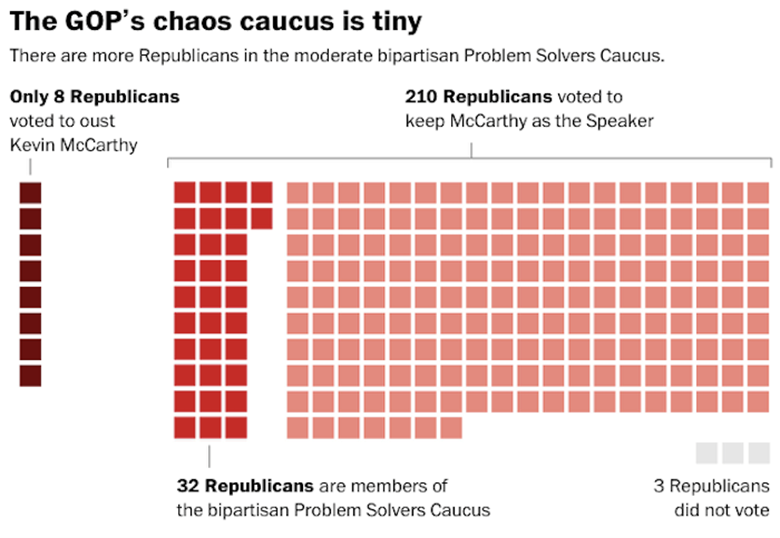
Those Republican Problem Solvers are very angry at the caucus’ Democratic members for not supporting McCarthy when he was dethroned. All the House Dems who voted, voted against McCarthy (208), while four Dems weren’t present.
So now, a government shut-down seems assured. But the reality is that despite the best wishes of the chaos caucus, the government cannot remain unfunded forever. And their demands for capitulation by Biden to the GOP’s fever dreams for cutting spending will never happen.
The House can’t do anything without a Speaker, so the pressure is massive to choose one. And the Republicans will probably find a way to choose one without requiring any Democratic votes to support their choice. But when government funding runs out in mid-November, we’ll get to the real logical driver of partisan politics, the absolute necessity to fund the government.
When the new Speaker can’t pass a funding bill that is supported by the Senate, the new Speaker will eventually see the value in again seeking Democratic support.
The math drives this. The functional majority in the House will be that group who are willing to pay our bills on time by funding the government. Of the 221 Republican House members, 130 of them voted to avoid the shutdown, and 91 voted for it. The new Speaker needs to wrangle 218 votes to pass a bill on to the Senate. So if only 130 Republicans are willing to govern, Democrats will have to supply the difference.
Roll Call reports that the Republican vote for the next Speaker will take place next Wednesday morning, so we’ll soon see if the impasse can be resolved.
Another interesting turnabout this week was the Biden administration deciding to waive two dozen environmental laws in order to resume building the wall on the southern border. Trump demanded an apology because Biden had promised in 2020 there would “not be another foot” of wall if he won.
The White House now claims the administration’s hands were tied by appropriations bills that required them to spend the money. Said Biden:
“The money was appropriated for the border wall…I tried to get them to reappropriate it, to redirect that money. They didn’t, they wouldn’t.”
Biden added he still doesn’t believe walls are an effective solution, but Republicans are crowing “I TOLD YOU SO” with this announcement. But since it was FY2019 money that couldn’t be reprogrammed, we should be asking why it wasn’t spent while Trump was still in office.
Wrongo is applying for a patent on his new invention. It’s called “the magic button”. You press it and any intractable problem simply disappears without a trace. It will be ready for use sometime after the 12th. The 12th of never.
On to the Saturday Soother, where we spend this Saturday of a three-day weekend attempting to escape from the news cycle. Wrongo and Ms. Right are on Cape Cod for our annual fall getaway that dovetails with the various Oysterfests on the Cape.
This means that columns may be light and variable for the next 10 days.
It’s raining in the Northeast, so, it’s mostly indoor sports today. To help you let go of the week’s news, grab a comfy chair by a window and brew up a cup of Kick Ass coffee from Canada’s Kicking Horse Coffee.
Now watch and listen to “My One And Only Love”, the old standard performed here by legendary saxophonist John Coltrane and singer Johnny Hartman. This was recorded in 1963 and features McCoy Tyner on piano. If you want to take your mind off a few things today, this will surely help: